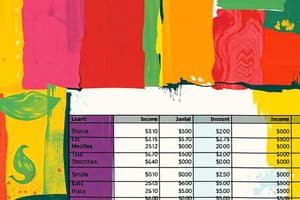Podcast
Questions and Answers
What is included in the Income Statement?
What is included in the Income Statement?
- Sales Revenue
- Depreciation
- Operating Income (EBITDA)
- All of the above (correct)
Why is the Income Statement not affected by changes in Inventory?
Why is the Income Statement not affected by changes in Inventory?
The expense is only recorded when the goods associated with it are sold (COGS).
What are the primary components of the Statement of Cash Flows?
What are the primary components of the Statement of Cash Flows?
- Net Income
- Operating Activities
- Investing Activities
- All of the above (correct)
What does the Balance Sheet represent?
What does the Balance Sheet represent?
How do the three financial statements link together?
How do the three financial statements link together?
If a company incurs $10 of depreciation, how does this affect the three financial statements?
If a company incurs $10 of depreciation, how does this affect the three financial statements?
If depreciation is a non-cash expense, why does it affect the cash balance?
If depreciation is a non-cash expense, why does it affect the cash balance?
Where does depreciation usually show up on the Income Statement?
Where does depreciation usually show up on the Income Statement?
How does a $100 cash purchase of equipment on Dec. 31 impact the three financial statements?
How does a $100 cash purchase of equipment on Dec. 31 impact the three financial statements?
How does a $100 debt purchase of equipment on Dec. 31 impact the three financial statements?
How does a $100 debt purchase of equipment on Dec. 31 impact the three financial statements?
If cash collected is not recorded as revenue, what happens to it?
If cash collected is not recorded as revenue, what happens to it?
Flashcards are hidden until you start studying
Study Notes
Income Statement
- Composed of five major sections: Sales Revenue, Cost of Goods Sold (COGS), Operating Expenses, Depreciation, Interest, and Taxes.
- Begins with Sales Revenue and ends with Net Income.
- Gross Profit is calculated as Sales Revenue minus COGS.
Impact of Inventory Changes on Income Statement
- Inventory changes do not affect the Income Statement until goods are sold, linking expense recognition to actual sales.
Statement of Cash Flows
- Reflects cash generation and usage, categorized into three activities: Operating, Investing, and Financing.
- Operating Activities include Net Income adjustments for non-cash items and changes in working capital accounts.
- Investing Activities cover capital expenditures and investments.
- Financing Activities consist of cash movements related to debts, dividends, and equity sales.
Balance Sheet
- Displays a company's financial position at a specific time, showcasing Assets, Liabilities, and Shareholder Equity.
- Assets are divided into Current (cash, accounts receivable, inventory) and Long-term (property, plant, and equipment).
- Equation: Assets = Liabilities + Shareholder Equity.
Linking the Three Financial Statements
- Net income from the Income Statement contributes to Shareholder Equity on the Balance Sheet and the Cash Flow Statement.
- Changes in Balance Sheet accounts influence cash flow due to working capital adjustments.
- Transactions in investing and financing activities modify items on the Balance Sheet.
Impact of Depreciation on Financial Statements
- A $10 pretax depreciation reduces EBIT by $10, resulting in a $6 decline in Net Income (assuming a 40% tax rate).
- Cash Flow Statement shows Net Income decrease of $6 and adds back depreciation, resulting in a $4 increase in cash flow from operations.
- On the Balance Sheet, Net Property, Plant & Equipment (PP&E) decreases by $10, while cash increases by $4, and retained earnings decrease by $6.
Depreciation's Role in Cash Flow
- Depreciation lowers taxable income, reducing the tax burden and thereby indirectly influencing cash reserves.
Presentation of Depreciation on Income Statement
- Can appear as a separate line item or included within COGS or Operating Expenses.
Cash Purchase of Equipment
- Year 1: $100 capital expenditure has no immediate impact on net income, cash flow from operations, or the Income Statement.
- Year 2: Straight-line depreciation leads to a $20 decrease in net income, an $8 increase in cash flow, and adjusted balances on the Balance Sheet.
Debt Purchase of Equipment
- Year 1: No immediate changes to Income Statement; $100 increase in capex reflected in cash flow from investing activities, with no net impact on cash.
- Year 2: Includes $20 depreciation and $10 interest expense, totaling an $18 decrease in net income, leading to a $2 increase in cash flow.
Treatment of Cash Collected Not Recorded as Revenue
- This cash is recorded as Deferred Revenue on the Balance Sheet under Liabilities until it is earned as revenue on the Income Statement.
Cash-based vs. Accrual-based Accounting
- Contrast between recognizing revenue and expenses when cash is exchanged (cash-based) versus when they are incurred or earned (accrual-based).
Studying That Suits You
Use AI to generate personalized quizzes and flashcards to suit your learning preferences.




